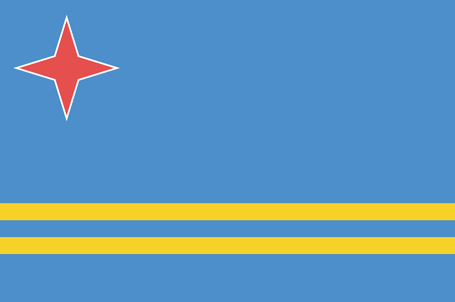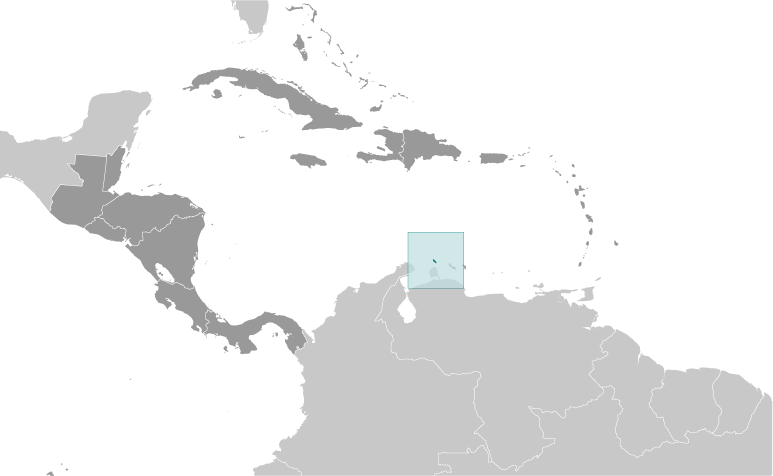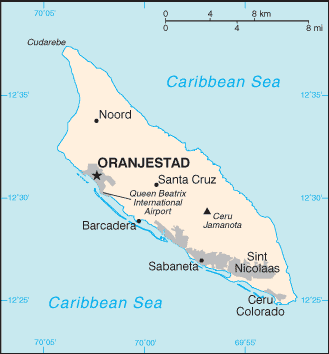Introduction :: ARUBA
-
Discovered and claimed for Spain in 1499, Aruba was acquired by the Dutch in 1636. The island's economy has been dominated by three main industries. A 19th century gold rush was followed by prosperity brought on by the opening in 1924 of an oil refinery. The last decades of the 20th century saw a boom in the tourism industry. Aruba seceded from the Netherlands Antilles in 1986 and became a separate, autonomous member of the Kingdom of the Netherlands. Movement toward full independence was halted at Aruba's request in 1990.
Geography :: ARUBA
-
Caribbean, island in the Caribbean Sea, north of Venezuela
12 30 N, 69 58 W
Central America and the Caribbean
total: 180 sq km
land: 180 sq km
water: 0 sq km
country comparison to the world: 218
slightly larger than Washington, DC
0 km
68.5 km
territorial sea: 12 nm
tropical marine; little seasonal temperature variation
flat with a few hills; scant vegetation
lowest point: Caribbean Sea 0 m
highest point: Ceru Jamanota 188 m
NEGL; white sandy beaches foster tourism
agricultural land: 11.1%
arable land 11.1%; permanent crops 0%; permanent pasture 0%
forest: 2.3%
other: 86.6% (2011 est.)
NA
hurricanes; lies outside the Caribbean hurricane belt and is rarely threatened
NA
a flat, riverless island renowned for its white sand beaches; its tropical climate is moderated by constant trade winds from the Atlantic Ocean; the temperature is almost constant at about 27 degrees Celsius (81 degrees Fahrenheit)
People and Society :: ARUBA
-
noun: Aruban(s)
adjective: Aruban; Dutch
Dutch 82.1%, Colombian 6.6%, Venezuelan 2.2%, Dominican 2.2%, Haitian 1.2%, other 5.5%, unspecified 0.1% (2010 est.)
Papiamento (official) (a Spanish-Portuguese-Dutch-English dialect) 69.4%, Spanish 13.7%, English (widely spoken) 7.1%, Dutch (official) 6.1%, Chinese 1.5%, other 1.7%, unspecified 0.4% (2010 est.)
Roman Catholic 75.3%, Protestant 4.9% (includes Methodist .9%, Adventist .9%, Anglican .4%, other Protestant 2.7%), Jehovah's Witness 1.7%, other 12%, none 5.5%, unspecified 0.5% (2010 est.)
112,162 (July 2015 est.)
country comparison to the world: 190
0-14 years: 17.69% (male 9,953/female 9,888)
15-24 years: 13.27% (male 7,470/female 7,417)
25-54 years: 42.59% (male 23,015/female 24,750)
55-64 years: 13.73% (male 7,114/female 8,287)
65 years and over: 12.72% (male 5,591/female 8,677) (2015 est.)
population pyramid:

total dependency ratio: 44%
youth dependency ratio: 26.4%
elderly dependency ratio: 17.6%
potential support ratio: 5.7% (2015 est.)
total: 39 years
male: 37.1 years
female: 40.8 years (2015 est.)
1.33% (2015 est.)
country comparison to the world: 89
12.56 births/1,000 population (2015 est.)
country comparison to the world: 157
8.18 deaths/1,000 population (2015 est.)
country comparison to the world: 92
8.92 migrant(s)/1,000 population (2015 est.)
country comparison to the world: 12
urban population: 41.5% of total population (2015)
rate of urbanization: -0.28% annual rate of change (2010-15 est.)
ORANJESTAD (capital) 29,000 (2014)
at birth: 1.02 male(s)/female
0-14 years: 1.01 male(s)/female
15-24 years: 1.01 male(s)/female
25-54 years: 0.93 male(s)/female
55-64 years: 0.86 male(s)/female
65 years and over: 0.64 male(s)/female
total population: 0.9 male(s)/female (2015 est.)
total: 11.37 deaths/1,000 live births
male: 14.94 deaths/1,000 live births
female: 7.74 deaths/1,000 live births (2015 est.)
country comparison to the world: 127
total population: 76.56 years
male: 73.5 years
female: 79.68 years (2015 est.)
country comparison to the world: 83
1.84 children born/woman (2015 est.)
country comparison to the world: 146
improved:
urban: 98.1% of population
rural: 98.1% of population
total: 98.1% of population
unimproved:
urban: 1.9% of population
rural: 1.9% of population
total: 1.9% of population (2015 est.)
improved:
urban: 97.7% of population
rural: 97.7% of population
total: 97.7% of population
unimproved:
urban: 2.3% of population
rural: 2.3% of population
total: 2.3% of population (2015 est.)
NA
NA
NA
6% of GDP (2011)
country comparison to the world: 41
definition: age 15 and over can read and write
total population: 97.5%
male: 97.5%
female: 97.5% (2015 est.)
total: 13 years
male: 13 years
female: 14 years (2012)
total: 28.9%
male: 29.9%
female: 27.5% (2010 est.)
country comparison to the world: 43
Government :: ARUBA
-
conventional long form: none
conventional short form: Aruba
constituent country of the Kingdom of the Netherlands; full autonomy in internal affairs obtained in 1986 upon separation from the Netherlands Antilles; Dutch Government responsible for defense and foreign affairs
parliamentary democracy
name: Oranjestad
geographic coordinates: 12 31 N, 70 02 W
time difference: UTC-4 (1 hour ahead of Washington, DC, during Standard Time)
none (part of the Kingdom of the Netherlands)
none (part of the Kingdom of the Netherlands)
Flag Day, 18 March (1976)
previous 1947, 1955; latest drafted and approved August 1985, enacted 1 January 1986 (regulates governance of Aruba, but is subordinate to the Charter for the Kingdom of the Netherlands); note - in October 2010, following dissolution of the Netherlands Antilles, Aruba became a constituent country within the Kingdom of the Netherlands (2015)
civil law system based on the Dutch civil code
see the Netherlands
18 years of age; universal
chief of state: King WILLEM-ALEXANDER of the Netherlands (since 30 April 2013); represented by Governor General Fredis REFUNJOL (since 11 May 2004)
head of government: Prime Minister Michiel "Mike" Godfried EMAN (since 30 October 2009)
cabinet: Council of Ministers elected by the Legislature (Staten)
elections/appointments: the monarchy is hereditary; governor general appointed by the monarch for a 6-year term; prime minister and deputy prime minister indirectly elected by the Staten for 4-year tern; election last held on 25 September 2009 (next to be held by September 2013)
election results: Michiel "Mike" Godfried EMAN (AVP) elected prime minister; percent of legislative vote - NA
description: unicameral Legislature or Staten (21 seats; members directly elected in a single nationwide constituency by proportional representation vote; members serve 4-year terms)
elections: last held on 27 September 2013 (next to be held in 2017)
election results: percent of vote by party - NA; seats by party - AVP 13, MEP 8
highest court(s): Joint Court of Justice of Aruba, Curacao, Sint Maarten, and of Bonaire, Sint Eustatitus and Saba or "Joint Court of Justice" (consists of the presiding judge, NA members, and NA substitutes); final appeals heard by the Supreme Court, in The Hague, Netherlands
note - prior to 2010, the Joint Court of Justice was the Common Court of Justice of the Netherlands Antilles and Aruba
judge selection and term of office: Joint Court judges appointed by the monarch for life
subordinate courts: Courts in First Instance
Aruban People's Party or AVP [Michiel "Mike" EMAN]
People's Electoral Movement Party or MEP [Evelyn WEVER-CROES]
Real Democracy or PDR [Andin BIKKER]
other: environmental groups
Caricom (observer), FATF, ILO, IMF, Interpol, IOC, ITUC (NGOs), UNESCO (associate), UNWTO (associate), UPU
none (represented by the Kingdom of the Netherlands); note - there is a Minister Plenipotentiary for Aruba at the Embassy of the Kingdom of the Netherlands
the US does not have an embassy in Aruba; the Consul General to Curacao is accredited to Aruba
blue, with two narrow, horizontal, yellow stripes across the lower portion and a red, four-pointed star outlined in white in the upper hoist-side corner; the star represents Aruba and its red soil and white beaches, its four points the four major languages (Papiamento, Dutch, Spanish, English) as well as the four points of a compass, to indicate that its inhabitants come from all over the world; the blue symbolizes Caribbean waters and skies; the stripes represent the island's two main "industries": the flow of tourists to the sun-drenched beaches and the flow of minerals from the earth
Hooiberg (Haystack) Hill; national colors: blue, yellow, red, white
name: "Aruba Deshi Tera" (Aruba Precious Country)
lyrics/music: Juan Chabaya 'Padu' LAMPE/Rufo Inocencio WEVER
note: local anthem adopted 1986; as part of the Kingdom of the Netherlands, "Het Wilhelmus" is official (see Netherlands)
Economy :: ARUBA
-
Tourism, petroleum bunkering, hospitality, and financial and business services are the mainstays of the small open Aruban economy. Tourist arrivals have rebounded strongly following a dip after the 2008 global financial crisis. Tourism now accounts for over 80% of economic activity. Over 1.5 million tourists per year visit Aruba, with 75% of those from the US. The rapid growth of the tourism sector has resulted in a substantial expansion of other activities. Construction continues to boom with hotel capacity five times the 1985 level. Aruba is heavily dependent on imports and is making efforts to expand exports to achieve a more desirable trade balance. Almost all consumer and capital goods are imported, with the US, the Netherlands, and Panama being the major suppliers. Aruba weathered two major shocks in recent years: fallout from the global financial crisis, which had its largest impact on tourism, and the closure of its oil refinery in 2009. However, tourism and related industries have continued to grow, and the Aruban government is working to attract more diverse industries. Aruba's banking sector withstood the recession well, and unemployment has significantly decreased.
$2.516 billion (2009 est.)
$2.258 billion (2005 est.)
$2.205 billion (2004 est.)
country comparison to the world: 190
$2.516 billion (2009 est.)
2.4% (2005 est.)
country comparison to the world: 130
$25,300 (2011 est.)
country comparison to the world: 70
household consumption: 63.3%
government consumption: 28.3%
investment in fixed capital: 22.9%
investment in inventories: NA%
exports of goods and services: 68.1%
imports of goods and services: -82.6%
(2013 est.)
agriculture: 0.4%
industry: 33.3%
services: 66.3% (2002 est.)
aloes; livestock; fish
tourism, petroleum transshipment facilities, banking
NA%
51,610
note: of the 51,610 workers aged 15 and over in the labor force, 32,252 were born in Aruba and 19,353 came from abroad; foreign workers are 38% of the employed population (2007 est.)
country comparison to the world: 192
agriculture: NA%
industry: NA%
services: NA%
note: most employment is in wholesale and retail trade, followed by hotels and restaurants
6.9% (2005 est.)
country comparison to the world: 78
NA%
lowest 10%: NA%
highest 10%: NA%
revenues: $622.6 million
expenditures: $849.4 million (2014 est.)
24.7% of GDP (2014 est.)
country comparison to the world: 125
-9% of GDP (2014 est.)
country comparison to the world: 203
67% of GDP (2013)
55% of GDP (2012)
country comparison to the world: 45
calendar year
0.4% (2014 est.)
-2.4% (2013 est.)
country comparison to the world: 40
1% (31 December 2010)
3% (31 December 2009)
country comparison to the world: 125
7.3% (31 December 2014 est.)
8.5% (31 December 2013 est.)
country comparison to the world: 118
$990.2 million (31 December 2014 est.)
$957.2 million (31 December 2013 est.)
country comparison to the world: 152
$1.942 billion (31 December 2014 est.)
$1.838 billion (31 December 2013 est.)
country comparison to the world: 157
$1.754 billion (31 December 2014 est.)
$1.656 billion (31 December 2013 est.)
country comparison to the world: 142
$236.5 million (2014 est.)
$278.5 million (2013 est.)
country comparison to the world: 184
live animals and animal products, art and collectibles, machinery and electrical equipment, transport equipment
Colombia 31.2%, Netherlands Antilles 21.7%, US 15.7%, Venezuela 12.4%, Netherlands 6.1% (2014)
$1.35 billion (2014 est.)
$1.364 billion (2013 est.)
country comparison to the world: 173
machinery and electrical equipment, refined oil for bunkering and reexport, chemicals; foodstuffs
US 56%, Netherlands 11.3% (2014)
$693.2 million (31 December 2014 est.)
$666.4 million (31 December 2013 est.)
country comparison to the world: 172
Aruban guilders/florins per US dollar -
1.79 (2014 est.)
1.79 (2013 est.)
1.79 (2012 est.)
1.79 (2011 est.)
Energy :: ARUBA
-
990 million kWh (2012 est.)
country comparison to the world: 149
920.7 million kWh (2012 est.)
country comparison to the world: 157
0 kWh (2013 est.)
country comparison to the world: 95
0 kWh (2013 est.)
country comparison to the world: 112
320,000 kW (2012 est.)
country comparison to the world: 149
90.6% of total installed capacity (2012 est.)
country comparison to the world: 73
0% of total installed capacity (2012 est.)
country comparison to the world: 34
0% of total installed capacity (2012 est.)
country comparison to the world: 154
9.4% of total installed capacity (2012 est.)
country comparison to the world: 39
0 bbl/day (2014 est.)
country comparison to the world: 102
0 bbl/day (2012 est.)
country comparison to the world: 92
229,000 bbl/day (2012 est.)
country comparison to the world: 31
0 bbl (1 January 2015 est.)
country comparison to the world: 102
234,600 bbl/day (2012 est.)
country comparison to the world: 48
6,400 bbl/day (2013 est.)
country comparison to the world: 163
234,600 bbl/day (2012 est.)
country comparison to the world: 30
6,341 bbl/day (2012 est.)
country comparison to the world: 150
1 cu m (2013 est.)
country comparison to the world: 96
1 cu m (2013 est.)
country comparison to the world: 114
1 cu m (2013 est.)
country comparison to the world: 51
1 cu m (2013 est.)
country comparison to the world: 75
0 cu m (1 January 2014 est.)
country comparison to the world: 107
876,400 Mt (2012 est.)
country comparison to the world: 168
Communications :: ARUBA
-
total subscriptions: 35,000
subscriptions per 100 inhabitants: 32 (2014 est.)
country comparison to the world: 169
total: 139,700
subscriptions per 100 inhabitants: 126 (2014 est.)
country comparison to the world: 185
general assessment: modern fully automatic telecommunications system
domestic: increased competition through privatization; 3 mobile-cellular service providers are now licensed
international: country code - 297; landing site for the PAN-AM submarine telecommunications cable system that extends from the US Virgin Islands through Aruba to Venezuela, Colombia, Panama, and the west coast of South America; extensive interisland microwave radio relay links (2007)
2 commercial TV stations; cable TV subscription service provides access to foreign channels; about 20 commercial radio stations broadcast (2007)
AM 2, FM 16, shortwave 0 (2004)
1 (1997)
.aw
total: 87,700
percent of population: 79.2% (2014 est.)
country comparison to the world: 172
Transportation :: ARUBA
-
1 (2013)
country comparison to the world: 210
total: 1
2,438 to 3,047 m: 1 (2013)
major seaport(s): Barcadera, Oranjestad
oil terminal(s): Sint Nicolaas
cruise port(s): Oranjestad
Military :: ARUBA
-
no regular military forces (2011)
males age 16-49: 24,891
females age 16-49: 26,202 (2010 est.)
males age 16-49: 20,527
females age 16-49: 21,493 (2010 est.)
male: 767
female: 743 (2010 est.)
defense is the responsibility of the Netherlands; the Aruba security services focus on organized crime and terrorism
Transnational Issues :: ARUBA
-
none
transit point for US- and Europe-bound narcotics with some accompanying money-laundering activity; relatively high percentage of population consumes cocaine
 Central Intelligence Agency
Central Intelligence Agency





